|
|
|
Sort Order |
|
|
|
Items / Page
|
|
|
|
|
|
|
| Srl | Item |
| 1 |
ID:
092120
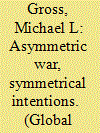

|
|
|
|
|
| Publication |
2009.
|
| Summary/Abstract |
During asymmetric war, a state actor often faces charges of disproportionate harm while the weaker, nonstate side must defend itself against charges of terrorism. Because the state actor faces an adversary embedded among civilians, and the nonstate actor confronts an opponent whose military targets are often so well protected that only its nonmilitary targets are vulnerable, it is difficult for either side to fight without harming civilians. While humanitarian law tries to protect noncombatants to the greatest extent possible, too strict an interpretation of terrorism and proportionality may unduly restrict either side's ability to pursue political claims by force of arms. To successfully walk the line between protecting civilians during asymmetric war and allowing each side a 'fighting chance', it is necessary to take another look at the idea of intentionality and the definition of combatants. While intentional harm is the hallmark of terrorism, state armies also bring intentional harm if they expect to glean military benefits from causing collateral damage to civilians. A tighter understanding of intentionality can further protect innocent, noncombatant civilians. At the same time, however, the international community must recognise that not all civilians are noncombatants. Many civilians take a direct or indirect role in the fighting. As such, some civilians are vulnerable to lethal harm while others remain subject to nonlethal harm. Asymmetric war expands the range of permissible civilian targets that each side may attack without incurring charges of terrorism or disproportionate harm.
|
|
|
|
|
|
|
|
|
|
|
|
|
|
|
|
| 2 |
ID:
092121
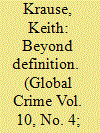

|
|
|
|
|
| Publication |
2009.
|
| Summary/Abstract |
While conceptualising violence - in either minimalist or comprehensive understandings - has posed significant problems for scholars, the problem of measuring or quantifying it has been equally challenging for both researchers and policy makers. This article examines the best available current evidence on the 'global burden of armed violence' and highlights what we know and do not know about the scope, scale, and distribution of different forms of violence worldwide, especially what policy makers have called 'armed violence' (the minimalist conception). It also examines the definitional and conceptual constraints that challenge any attempt to develop cross-national and cross-cultural comparisons, and the limitations of existing data, and brings the empirical evidence to bear on the conceptual debates that animate this volume. Finally, it raises some questions concerning the way in which the different forms that violence takes may (or may not) be linked, and the issues this raises for future 'global' comparisons.
|
|
|
|
|
|
|
|
|
|
|
|
|
|
|
|
| 3 |
ID:
092122


|
|
|
|
|
| Publication |
2009.
|
| Summary/Abstract |
This article looks at the history of economic sanctions as a tool of global governance. For much of the twentieth century, sanctions were seen as a non-violent alternative to military intervention. As a form of international governance, sanctions have always been characterised by conflicting claims: that sanctions are effective enough to punish or block wrongful acts by states; but they are at the same time measures that will not cause damage to the population as a whole, in the way that warfare does. The sanctions imposed on Iraq by the United Nations Security Council illustrate how sanctions at their most extreme can in fact be fully as damaging as warfare.
|
|
|
|
|
|
|
|
|
|
|
|
|
|
|
|
| 4 |
ID:
092118
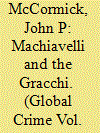

|
|
|
|
|
| Publication |
2009.
|
| Summary/Abstract |
In this article, I highlight a rhetorical strategy in Machiavelli's Discourses through which: (1) the Florentine endorses, despite appearances to the contrary, the redistributive agenda of the Brothers Gracchi, Roman tribunes frequently blamed for causing the collapse of the Republic; and (2) subtly intimates the violent means that other prospective reformers of republics must employ to succeed where the Gracchi had failed. Machiavelli invokes 'prudence' in his passages devoted to the Gracchi; following this lead, I accentuate the form of prudential rhetoric that he practices in such passages, and I point to the prudential form of violence he thought necessary if republics were to, in his words, 'keep the public rich, and the citizens poor'.
|
|
|
|
|
|
|
|
|
|
|
|
|
|
|
|
| 5 |
ID:
092125
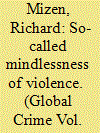

|
|
|
|
|
| Publication |
2009.
|
| Summary/Abstract |
This article proposes that violence may be most usefully thought about as a psychological rather than a behavioural phenomenon. Violence, it is contended, is a pathological variant of aggression, where 'aggression' is used to describe a particular part of the range of affective endowments possessed by human beings. We might think about aggression as a 'set' of which violence is a subset. As an affective endowment, aggression requires integration during development and this is supplied initially by an infant's primary carers and later by other important objects and institutions in the environment and culture in which the growing child lives. In the absence of the required conditions for enabling psychological integration to take place, rather than integration, disintegration holds sway with the aggressive affects denied or dissociated from. In this instance the affects do not become part of the affective repertoire upon which the individual can draw in order to orientate him or herself to their environment and in particular objects in the environment. Instead the affect is experienced as exterior and other and in some circumstances as violating. In this circumstances violence is resorted to as a way of escaping from the experience of overwhelming affects, for example by evoking in another affective experiences that cannot be tolerated within the self. Clinical case material is used to illustrate this.
|
|
|
|
|
|
|
|
|
|
|
|
|
|
|
|
| 6 |
ID:
092123


|
|
|
|
|
| Publication |
2009.
|
| Summary/Abstract |
Violence is one of the most important causes of suffering and death on the planet. The incidence of different forms of violence varies markedly within and between populations with high rates of violence driven largely by poverty and social injustice and sustained by inept policy responses rooted in legal and moral frameworks. Violence therefore poses a major challenge for public health which is the discipline concerned with assuring the conditions for a healthy society. Over the past five decades it has become increasingly clear that public health has important contributions to make to the challenge of understanding and preventing violence, contributions which extend and complement conventional legal and moral approaches to violence. This work was led initially by the US Centre for Disease Control (CDC) and more recently by the World Health Organisation (WHO) which in 2002 published the first World Report on Violence and Health. Public health is a relatively atheoretical discipline. While a number of useful theoretical frameworks have emerged to better understand and prevent violence, there is no agreed or dominant public health theory of violence. James Gilligan has proposed a detailed and potentially useful public health theory of violence based on the notion that shame/humiliation, which violates an individual's self-respect and dignity, is the pathogen that causes violence; a pathogen intimately linked with cruelty and neglect in childhood, spread by the vector of inequalities in power, wealth and status in society and sustained by punishment and humiliation within the criminal justice system. This notion of violence resonates with Vittorio Bufacchi's concept of violence as a violation of integrity.
|
|
|
|
|
|
|
|
|
|
|
|
|
|
|
|
| 7 |
ID:
092119
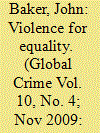

|
|
|
|
|
| Publication |
2009.
|
| Summary/Abstract |
Should radical egalitarians operating in contemporary capitalist democracies use political violence to achieve their aims? Purely consequentialist arguments provide too simple an answer. Machiavelli's perspective is more complex because it contains both consequentialist and non-consequentialist elements and because of its emphasis on the strictly political costs and benefits of violence. The radically egalitarian ideal of equality of condition is similarly complex but involves very different values and objectives. These generate both moral and political arguments against violence. However, the threat of counter-revolutionary violence creates a dilemma for radical egalitarians that it is difficult to resolve.
|
|
|
|
|
|
|
|
|
|
|
|
|
|
|
|
| 8 |
ID:
092124
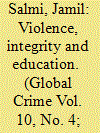

|
|
|
|
|
| Publication |
2009.
|
| Summary/Abstract |
In many parts of the world, schools, which are supposedly the main social venue for intellectual enrichment and value formation, are often places of suffering and distress, raising important questions about the relationship between violence and education. What are the different forms of violence that can be encountered in a schooling setting? How prevalent are these manifestations of violence? Do they occur in a random fashion or are they associated with specific factors and patterns? What can be done to reduce or eliminate their occurrence? To begin to address these questions, this article is divided into three parts. First, it proposes an analytical framework to identify, in a systematic way, the various forms of violence that can take place within the ambit of school systems. Second, it shows how this typology can be applied along the various analytical dimensions developed. Finally, it reviews ways in which education can be used as a positive force to address violence issues in the school context and beyond.
|
|
|
|
|
|
|
|
|
|
|
|
|
|
|
|
|
|
|
|
|